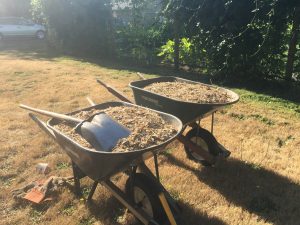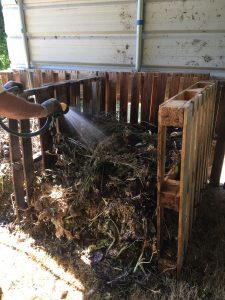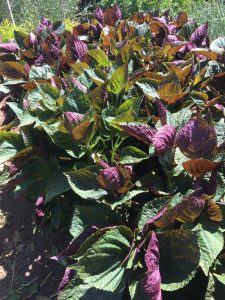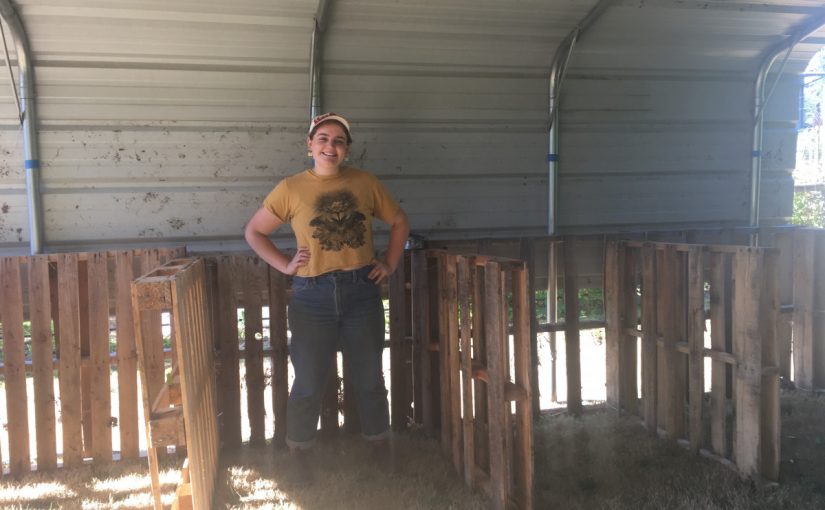Hurrah for Week IV! By now, I have gotten into the full swing of routine at Urban Futures Farm. With TJ, Stephanie, a flock of volunteers (all past or present Evergreeners) and I, farm tasks go by smoothly, or at least as smoothly as they can!
Tuesday
TJ discovered early in the morning that the walk-in cooler had begun to malfunction and was not getting to temperatures cool enough for storing produce properly, i.e. 38° F. He explained to me how the walk-in was constructed and why it was malfunctioning.
The walk-in cooler is a square insulated structure in the garage right next to the CSA packing area constructed in 2017. TJ uses a A/C unity with an attached CoolBot Walk-In Cooler Controller that overrides the A/C unit and forces it down to temperatures lower than it usually reaches. It does this by hooking up temperature sensors to the A/C unit that continuously tells it to cool and cool, until it gets to 38° F. It was invented by a fellow farmer and allows for small-scale farmers to easily and relatively affordably create walk-ins for their produce!
Unfortunately, if the temperature sensors frost up (which they will), the A/C unit will stop running as it senses that temperatures have been met (there’s some AI for you). TJ gently brushed the frost off the sensors, and the cooler began to run again with no issues. This is only a slight drawback to an overall great system!
For the rest of the day we finalized the compost structure. It is now 80% complete! The following is a step-by-step outline of how we constructed the system:
- First, we finished up the carport by adding the final panels with the help of numerous self tapping screws and a couple rickety ladders. The panels on the westerly side of the carport come down the farthest in order to protect the active compost bins (also constructed on the westerly side) from the elements. On the eastern side, the panels only come down slightly. This will ensure adequate airflow through the carport and hopefully diminish compost smells.
-

TJ wires together old pallets that were taken apart from the last compost structure. Photo taken by Kela Once the carport was up, we began to wire together old wooden pallets in order to construct the five active bins on the westerly side. Much thought went into the sizing of these bins, but we ended up going with the largest bins available. The front of each bin was left open in order for a wire gate to be put on the front.
- We only had enough material to fill two of the active bins. Feedstocks included a layer of old raspberry canes on the bottom of each pile, and then lasagna style of chicken bedding and rotting vegetable trimmings. TJ has been collecting the trimmings over the past 6 or so months, so some of them had begun to partially compost in the piles.
-

Chicken bedding. A source of ammonia. It initially was smelly but by the next day, all ammonia odor was gone. This is a good sign as likely nitrogen is our limiting nutrient for the microorganisms in the compost pile! Photo taken by Kela 
Vegetable trimmings. A good source of both nitrogen and carbon. Weeds have not yet been added to the compost piles, as it is important to have a stable system before introducing feedstocks that are broken down in a more complex manner. Photo taken by Kela

Each layer was watered in for approximately a minute. Moisture content is vital for successful composting systems. All of the journal articles I have read have suggested 40% moisture content as a necessary percentage for the eradication of plant pathogens. I am unsure how to take moisture content readings of TJ’s pile, but I will hopefully figure this out and report back!
There was already sign of life in the compost piles. Numerous invertebrate detritivores came up to greet the water, including isopods, earthworms, larvae of what I presume to be beetles, and likely many other microscopic invertebrates unseen. Throughout the piles we found signs of mycelial life as well, including numerous dried up morels. This is also a good sign!
Wednesday

Wednesday was another CSA day. We harvested chard, cabbages, and bok choi for the CSA’s. I also helped make bouquets for the first time, which was incredibly exciting! I especially love the edible shiso Stephanie puts in the bouquets. They are a great frill for around the bouquets and offer up a slightly citrusy smell. In flavor, it tastes slightly like licorice and is quite strong. It is in the mint family, and thus does very well in this PNW climate and soil.
TJ purchased a compost thermometer and we monitored temperatures of the compost throughout the day. Early morning, the compost pile was approximately 80° F. By the end of the day, the compost pile had shot up to 150° F. That is a wild range in temperature! We will continuing monitoring the temperatures as well as the progress of the compost.

